What’s the Best Way to Prepare a Delicate Crab Bisque with Fresh Herbs?

A delicate crab bisque is a staple in many kitchens, especially among seafood enthusiasts. A bisque is a creamy, flavorful soup usually made from pureed seafood and broth. Its rich, velvety texture is a delight to the palate and is enough to elevate any meal. But what makes a bisque truly exceptional? How can one ensure its depth of flavor and creamy consistency? And most importantly, what is the best way to prepare a delicate crab bisque with fresh herbs?
Let’s delve into this culinary endeavor, exploring the necessary elements in preparing a bisque, the crucial process of extracting flavors, and how to incorporate crab and fresh herbs into this exquisite dish.
Also read : What’s the Secret to Crafting a Perfectly Smooth Pumpkin Pie with a Ginger Snap Crust?
Selecting Your Seafood: The Importance of Fresh Crab Meat
The key to an exceptional crab bisque lies in the quality of your seafood. Fresh crab meat is not only rich in flavor, but it also lends an unparalleled texture to the soup. Moreover, the essence of the crab, when released into the broth, provides a depth of flavor that is hard to replicate with other ingredients.
When selecting crab for your bisque, opt for whole crabs when possible. Whole crabs allow you to extract more flavor for your stock, using both the meat and the shells. If whole crabs are unavailable, lump crab meat can also be used. Just make sure that it is fresh and devoid of any artificial preservatives.
This might interest you : What’s the Best Method for a Perfectly Balanced Spicy Sichuan Stir-Fry?
Building Your Base: The Foundation of Flavor
The next step in creating your crab bisque is to build a flavorful base, known as the stock. The stock is essentially a broth made by simmering ingredients such as bones, vegetables, and herbs. In the case of a crab bisque, the stock is typically made by simmering crab shells with a combination of aromatic vegetables and herbs.
Start by sautéing a mixture of onions, carrots, and celery in a large pot, until they have softened and released their juice. Add the crab shells to the pot and let them cook until they turn a vibrant red. Add garlic and bay leaves for an extra layer of flavor. Once your base ingredients have sufficiently cooked, cover them with water and let the concoction simmer for a good 45 minutes. This process allows the flavors to meld together and form a robust, flavorful stock.
Creamy Consistency: The Role of Cream in Bisque
A bisque wouldn’t be a bisque without its signature creamy consistency. This is achieved by adding cream to the soup. However, cream does more than just add to the soup’s texture. It also enhances the flavor of the bisque, adding a richness that complements the delicate taste of the crab.
When the stock is ready, strain it to remove the solids. Return the clear broth to the heat and add the crab meat. Let this simmer for a few minutes to allow the crab flavor to permeate the broth. Then, add the cream to the soup, stirring gently to fully incorporate it. Keep the soup on low heat, being careful not to let it boil, as this can cause the cream to separate and spoil the texture of the bisque.
Enhancing Flavor: The Addition of Shrimp and Fresh Herbs
To further enhance the flavor of your crab bisque, consider adding shrimp and fresh herbs. Shrimp provides an extra layer of seafood flavor and a delightful contrasting texture. Fresh herbs, on the other hand, lend a refreshing note that balances the richness of the soup.
To incorporate these ingredients, simply add peeled and deveined shrimp to your soup during the last few minutes of cooking. As for the herbs, you can add a combination of fresh thyme, parsley, or dill right before serving. The heat from the soup will wilt the herbs just enough to release their aroma without overpowering the other flavors.
The Finishing Touches: Perfecting Your Crab Bisque
The final stage in preparing your crab bisque is perfecting it with the right finishing touches. This could be a splash of sherry, a sprinkle of paprika, or a squeeze of fresh lemon juice. These additions can enhance the overall flavor profile of the soup, providing a hint of acidity or heat that cuts through the creaminess of the bisque.
To incorporate these finishing touches, simply stir in your chosen enhancements during the last few minutes of cooking. Always taste your bisque afterwards to ensure a balanced flavor profile. And remember, the goal is to complement the delicate flavor of the crab, not overpower it.
Ultimately, the best way to prepare a delicate crab bisque with fresh herbs relies on using the freshest ingredients, building a robust base of flavors, and perfecting your soup with the right finishing touches. With a pinch of patience and a dash of love, you’ll be sure to create a crab bisque that is not only delicious but also worthy of any fine dining experience.
The Essential Extras: Enhancing Flavor with Key Ingredients
To make a truly unforgettable crab bisque, we can’t forget the essential extras. These are the ingredients that, while not the main players, help create a rich and complex flavor profile sure to impress even the most discerning palates.
Salt and pepper are your basic seasonings, and they play a crucial role in highlighting the natural flavors of your seafood. Add them gradually to your bisque, tasting as you go along to find the right balance.
Bay leaves are a common ingredient in many soups and stews. They add a subtle yet distinct flavor that enhances the seafood stock and crab meat. Remember to remove them before serving, as they are not meant to be eaten.
Tomato paste can add a nice tangy note and a beautiful color to your crab bisque. It’s ideal for balancing out the rich, creamy elements of the bisque. If you prefer a more traditional, cream-based bisque, you can leave this out.
Seafood seasoning or Old bay seasoning is a mix of spices that’s perfect for enhancing any seafood dish. It usually contains celery salt, black pepper, crushed red pepper flakes, and paprika. This seasoning adds a depth of flavor to your bisque, and a dash of heat.
White wine is not a must, but it can add an extra layer of flavor to your bisque. The acidity of the wine can help balance out the richness of the bisque, while the alcohol will cook off, leaving only its subtle flavors.
As for the heavy cream, it is best added at the end of the cooking process. This helps prevent the cream from curdling and ensures a smooth, velvety texture.
Conclusion: From Recipe to Table
Creating a delicate crab bisque with fresh herbs may seem daunting at first, but with careful selection of ingredients and attention to detail, it becomes a rewarding culinary venture. Starting with fresh crab meat, building a flavorful seafood stock, and enhancing it with aromatic herbs works wonders in creating a bisque that’s rich in flavor and pleasingly velvety in texture.
Remember to be patient with the process. The time you invest in simmering the stock, sautéing the vegetables, and gently folding in the cream results in a bisque that’s worth every minute. The key here is balance – balance in flavors, textures, and even colors. This way, you bring out the best of what each ingredient has to offer, making your crab bisque the star of the show.
Lastly, don’t forget to add your personal touch. Whether it’s a unique blend of herbs, a hint of wine, or an extra pinch of spice, a personalized touch can make your crab bisque truly your own. Happy cooking!
